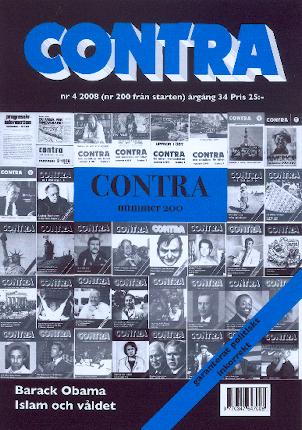
Contra # 200
This is the 200th issue of Contra magazine. In the mid four pages there is a short review of the 200 first issues as well as minitaures of all 200 covers.
A socialist in the White House?
by Tommy Hansson
Democratic presidential candidate Barack Obama have for twenty years had close contacts with unrepentant members of terrorist organization Weather Underground, And there are more skeletons in the cupboard.
Tommy Hansson has studied the background of Obama. In addition to many doubtful persons in his surroundings he has a very solid leftist vote record. And his statements do question basic American values. But he is an eloquent orator (although the contents of his key word ”change” is really thin). And he has got a very important support from the media and left-leaning billionaires.
Religions of peace and violence
by C G Holm
Almost all world religions advocates peace and humbleness. With one exception. Islam has all the time since Mohammad been a religion linked to violence.
Still close to 1400 years after Mohammad this can be noted. There is only one country with a weapon on its flag – Saudi Arabia. In ten of the fourteen countries with major armed conflicts (listed by the Stockholm Peace Research Institute) islam is at least one party in the conflict (in some there are two moslem parties).
Hinduism shows a great tolerance for dissident thinking, eastern teaching (confucianism and taoism) are conservative philosophies, much against military violence to change the existing order, but supportive of military defence of the existing order. Buddhism and christianity are both religions where violence is seen as something evil. Islam, on the other hand, sees violence as an integrated part of the endeavours to make islam a world dominating religion.
The family and the dictatorship of political corrctness
by Tommy Hansson
In the end of June Tommy Hansson was, as Ambassador for Peace in the Universal Peace Federation (UPF), invited to a conference in Bad Homburg in Germany. The conference lasted three days and was part of a series arranged by UPF under the collective name European Leadership Conferences (ELC). The purpose of these European conferences is to work for increased understanding across national, cultural and religious borders, thus contriobuting to an international peace culture. Tommy Hansson tells more about it.
Realism and idealism in American foreign policy
by Fredrik Runebert
USA has always tried to combine idealism and realism in its foreign policy. That’s claimed by Secretary of State Condoleezza Rice in the most recent issue of the respected journal Foreign Affairs. In the löng run the objective is to promote democracy and freedom, but in the short term other more strategic goals have influenced the policy of the United States. During certain periods either idealism or realism has dominated the policy. The Nixon era could be regarded as a period of realism and the Reagan era as a period of idealism. But even if Ronald Reagan was one of the more explicitly conservative leaders of America, he also considered strategic factors. Thus Reagan could make agreements with Gorbachev on mutual disarmament.
Iran is threatening world peace
After four years as Israeli Ambaasador Eviatar Manor leaves. Mr Manor has been morer low-key than his predecessor, but now when leaving talks about Iran as a threat against world peace.
The information society as a threat in modern times
by Stig Daun
If statistics of the average time use of Swedes is correct we daily have a large intake of violence and misery through television. Every day, all the year. Year after year. Seldom the effects of this is mentioned in media, why should they tell the public of their own shortcomings. Which effects does violence on TV have on the public? And especially on children. Psychiatrists can tell about it.
Count Hamilton and other Swedes at War
by David Stavenheim
Sweden has not been at war for close to 200 years. In spite of this a lot of Swedes have been involved in wars and armed conflicts, also disregarding UN peacekeeping operations. The book ”Swedes at War 1914–1945” by Lars Gyllenhaal and Lennart Westberg tells a large number of dramatic and curious individual dramas.

